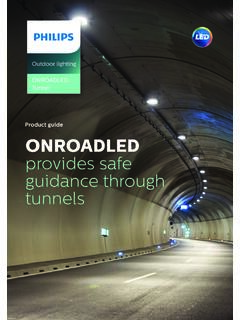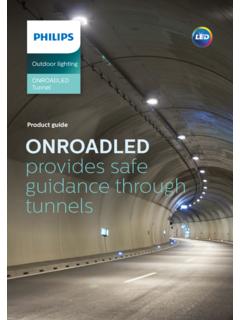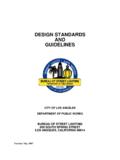Transcription of Chapter Thirteen HIGHWAY LIGHTING DESIGN Table of …
1 November 2007 HIGHWAY LIGHTING DESIGN 13(i) Chapter Thirteen HIGHWAY LIGHTING DESIGN Table of Contents Section Page (1) Adherence to DESIGN (1) DESIGN Exceptions .. (1) (1) (2) (2) Project/Plan Development Responsibilities .. (3) Definition of Terms .. (4) GUIDELINES FOR JUSTIFYING HIGHWAY LIGHTING .. (1) Analyzing HIGHWAY LIGHTING Needs .. (1) (1) Continuous Freeway (1) Complete Interchange (2) Partial Interchange (2) Crossroad Ramp Terminal (3) Streets and Highways Other Than Freeways .. (3) Rest (5) Weigh Stations .. (5) (5) (6) Other Locations .. (6) Roadway (7) LIGHTING EQUIPMENT .. (1) (1) Light Standards (Poles).. (1) Mast (4) (5) 13(ii) HIGHWAY LIGHTING DESIGN November 2007 Table of Contents (Continued) Section Page Light (5) Optical (6) (6) Housing Units.
2 (7) Other Equipment .. (7) LIGHTING DESIGN (1) Illuminance (1) Luminance Methodology .. (1) Small-Target-Visibility (STV) Methodology .. (2) DESIGN PROCEDURES .. (1) Computerized DESIGN .. (1) DESIGN Process .. (1) DESIGN (1) Classifications .. (1) Roadway (2) Area Classification .. (3) Pavement (3) DESIGN (4) Equipment (6) Light Distribution .. (6) Mounting (13) Coefficient of (13) Light Loss Factors .. (13) Luminaire Arrangement .. (15) Roadside Safety (19) Other (21) Voltage Drop Determination .. (22) HIGH-MAST LIGHTING (1) November 2007 HIGHWAY LIGHTING DESIGN (1) Chapter Thirteen HIGHWAY LIGHTING DESIGN GENERAL The purpose of HIGHWAY LIGHTING is to provide a safe and comfortable environment for the nighttime driver. Due to the volume of HIGHWAY LIGHTING system DESIGN information, it would be impractical for this Chapter to present a complete HIGHWAY LIGHTING DESIGN guide .
3 For additional DESIGN information, the designer is encouraged to review the latest edition of the references listed in Section The intent of this Chapter is to provide the user with a synopsis of the HIGHWAY LIGHTING DESIGN process and to present MDT s criteria, policies and procedures on these issues. Adherence to DESIGN Criteria Chapter Thirteen presents the DESIGN criteria for the application of HIGHWAY LIGHTING on individual projects. In general, the designer is responsible for making every reasonable effort to meet these criteria. However, recognizing that this will not always be practical, the following sections discuss the Department s procedures for identifying, justifying and processing exceptions to the governing HIGHWAY LIGHTING DESIGN criteria. DESIGN Exceptions The designer must seek an internal MDT DESIGN exception when the proposed HIGHWAY LIGHTING DESIGN criteria does not meet the following: 1.
4 Chapter Six, Roadside Safety, MDT Traffic Engineering Manual; and 2. MDT Policies from the Chief Engineer or Director. Documentation The type and detail of documentation needed to justify a DESIGN exception will vary on a case-by-case basis. The following is a list of potential items which may need to be documented for a specific DESIGN exception: 1. crash data, 2. environmental impacts, 3. right-of-way impacts, (2) HIGHWAY LIGHTING DESIGN November 2007 4. construction costs, and 5. serviceability impacts. Procedure The following procedure will be used to process an identified DESIGN exception: 1. Project Engineer. The Project Engineer will assemble the documentation for the DESIGN exception request.
5 See Section of the MDT Road DESIGN Manual. This package will be submitted to the Traffic Engineer. 2. Traffic Engineer. The Traffic Engineer will review the DESIGN exception package and, if in agreement, will sign the request. In rare cases where the Traffic Engineer believes necessary, the DESIGN exception request may be submitted to the Traffic and Safety Bureau Chief. References For information applicable to MDT HIGHWAY LIGHTING DESIGN projects, see the following publications: 1. Roadway LIGHTING DESIGN guide , AASHTO; 2. American National Standard Practice for Roadway LIGHTING , RP-8, Illuminating Engineering Society of North America; 3. Recommended Practice for tunnel LIGHTING , Illuminating Engineering Society of North America; 4. Recommended LIGHTING for Walkways and Class 1 Bikeways, Illuminating Engineering Society of North America; 5.
6 Standard Specifications for Structural Supports for HIGHWAY Signs, Luminaires and Traffic Signals, AASHTO; 6. Roadside DESIGN guide , AASHTO; 7. Standard Specifications for Road and Bridge Construction, MDT; 8. MDT Detailed Drawings, MDT; 9. MDT Electrical Detailed Drawings, MDT; 10. Chapter Six, Roadside Safety, MDT Traffic Engineering Manual; November 2007 HIGHWAY LIGHTING DESIGN (3) 11. Chapter Fourteen, Roadside Safety, MDT Road DESIGN Manual; 12. Chapter Eight, Project Development Process, MDT Traffic Engineering Manual; 13. Chapter Nine, Project Coordination, MDT Traffic Engineering Manual; 14. Chapter Ten, Plan Preparation, MDT Traffic Engineering Manual; 15. ALADAN A GE LIGHTING Application DESIGN and Analysis Computer Program, General Electric LIGHTING Systems; 16.
7 LIGHTING DESIGN guide for Use with ALADAN, General Electric LIGHTING Systems; 17. Roadway LIGHTING Handbook, FHWA; 18. Warrants for HIGHWAY LIGHTING , NCHRP Report No. 152, TRB; 19. Partial LIGHTING of Interchanges, NCHRP Report No. 256, TRB; 20. A guide to Standardized HIGHWAY LIGHTING Pole Hardware, AASHTO; and 21. National, state, and local electrical codes. Project/Plan Development Responsibilities The following list provides information on HIGHWAY LIGHTING project and plan development responsibilities: 1. Project Development. Chapter Eight presents a network which describes the project development sequence when HIGHWAY LIGHTING is a part of the construction project. 2. Project Coordination. During the development of a HIGHWAY LIGHTING project, the designer must coordinate with many units internal and external to the Electrical Unit.
8 Chapter Nine discusses specific coordination responsibilities between the designer and other units and applies both to a project for which the Electrical Unit is serving as the lead unit and to a project for which the Electrical Unit is providing project support when another unit is project lead ( , the Road DESIGN Section). 3. Plan Development. Chapter Ten presents the Department s criteria for developing a set of plans applicable to HIGHWAY LIGHTING projects. Chapter Ten contains information on scale sizes, CADD requirements, plan sheet requirements, quantities, etc. (4) HIGHWAY LIGHTING DESIGN November 2007 Definition of Terms The following defines the more commonly used terms in HIGHWAY LIGHTING DESIGN : 1.
9 Average Initial Illuminance. The average level of horizontal illuminance on the pavement area of a traveled way at the time the LIGHTING system is installed when lamps are new and luminaires are clean; expressed in average footcandles (fc) (lux) for the pavement area. See definition of illuminance, footcandle and lux. 2. Average Maintained Illuminance (Eh). The average level of horizontal illuminance on the roadway pavement when the output of the lamp and luminaire is diminished by the maintenance factors (LLD and LDD); expressed in average footcandles (fc) (lux) for the pavement area. 3. Ballast. A device used with an electric-discharge lamp to obtain the necessary circuit conditions (voltage, current and wave form) for starting and operating. It limits the current through the lamp and may also transform voltage.
10 4. Blinding Glare. Glare so intense that for an appreciable length of time no object can be seen. 5. Candela (cd). A measure of the luminous intensity of a light source as seen by the eye. For example, because the eye is less sensitive to blue light than to green light, a blue light source must radiate more power in watts (W) than must a green light source if the two are to have the same luminous intensity. Most light sources have different luminous intensities when viewed from different directions and so the luminous intensity for a light source may vary with the angle at which it is viewed. 6. Candela per Square Meter (cd/m2). The International System (SI) unit of luminance (photometric brightness) equal to the uniform luminance of a perfectly diffusing surface emitting or reflecting light at the rate of one lumen per square meter (lm/m2) or the average luminance of any surface emitting or reflecting light at that rate.









